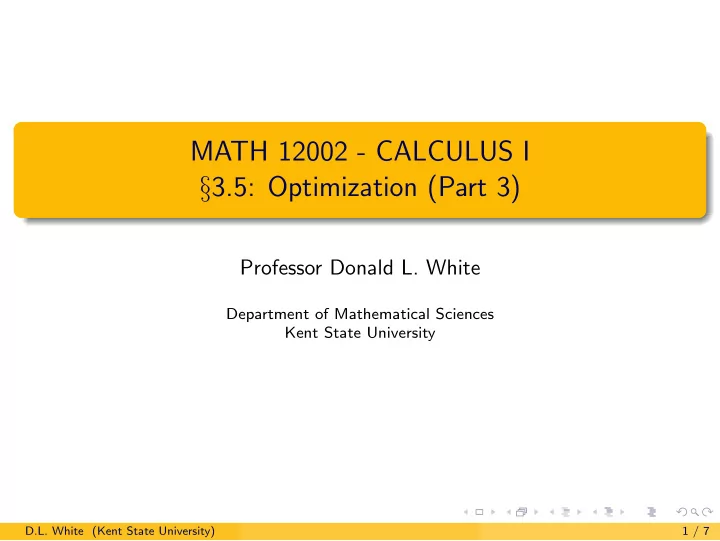

MATH 12002 - CALCULUS I § 3.5: Optimization (Part 3) Professor Donald L. White Department of Mathematical Sciences Kent State University D.L. White (Kent State University) 1 / 7
Example 1 Example 1 A box with an open top is to be constructed from a square piece of cardboard, 3 feet wide, by cutting out a square from each of the corners and bending up the sides. Find the largest volume that such a box can have. 3 3 x x x x ✻ 3 3 − 2 x 3 ❄ ✛ 3 − 2 x ✲ With x equal to the length of a side of the cut-out square, the volume is V ( x ) = x (3 − 2 x ) 2 and 0 � x � 1 . 5. D.L. White (Kent State University) 2 / 7
Example 1 We want to find the absolute maximum value of V ( x ) = x (3 − 2 x ) 2 on the closed interval [0 , 1 . 5]. We need the derivative in order to find any critical numbers of V ( x ): 1 · (3 − 2 x ) 2 + x · 2(3 − 2 x ) 1 · ( − 2) V ′ ( x ) = = (3 − 2 x )[(3 − 2 x ) + x · 2 · ( − 2)] = (3 − 2 x )[(3 − 2 x ) − 4 x ] = (3 − 2 x )(3 − 6 x ) . The critical numbers of V ( x ) are then x = 3 / 2 = 1 . 5 and x = 1 / 2 = 0 . 5. Evaluating V ( x ) at the critical numbers and endpoints, we have 0 · (3 − 2(0)) 2 = 0 V (0) = 1 . 5 · (3 − 2(1 . 5)) 2 = 1 . 5 · (3 − 3) 2 = 0 V (1 . 5) = 0 . 5 · (3 − 2(0 . 5)) 2 = 0 . 5 · (3 − 1) 2 = 2 , V (0 . 5) = and the largest possible volume is 2 cubic feet. D.L. White (Kent State University) 3 / 7
Example 2 Example 2 A llama farmer wishes to enclose a rectangular field of 20000 square feet with a fence. For the side running along the road, he will use fencing that costs $3 per foot and for the other 3 sides he will use fencing that costs $1 per foot. What dimensions will minimize the cost of the fence? y x x y ROAD Let x = length of the side perpendicular to the road; y = length of the side parallel to the road. Given: Area = xy = 20000 square feet. Minimize: Cost C of fence. D.L. White (Kent State University) 4 / 7
Example 2 The fence has two sides, each of length x , that cost $1 per foot. one side of length y that costs $1 per foot; one side of length y that costs $3 per foot; Hence the cost of the fence is C = x + x + y + 3 y = 2 x + 4 y . Using the constraint xy = 20000, so y = 20000 / x , we have C ( x ) = 2 x + 4 · 20000 = 2 x + 80000 x − 1 . x D.L. White (Kent State University) 5 / 7
Example 2 We want to find the absolute minimum value of C ( x ) = 2 x + 80000 x − 1 on (0 , ∞ ). We need the derivative in order to find any critical numbers of C ( x ): 2 − 80000 x − 2 C ′ ( x ) = 2 − 80000 = x 2 2 x 2 − 80000 = x 2 2( x 2 − 40000) = x 2 2( x − 200)( x + 200) = . x 2 D.L. White (Kent State University) 6 / 7
Example 2 Since C ′ ( x ) = 2 − 80000 x − 2 = 2( x − 200)( x + 200) , x 2 the only critical number on the interval (0 , ∞ ) is x = 200. Verify that C ( x ) has an absolute minimum at x = 200: C ′′ ( x ) = 160000 x − 3 , so C ′′ (200) = 160000 / 200 3 is positive. By the Second Derivative Test, C has a local minimum at x = 200. The domain of C is an interval and C has only one critical number, hence C has an absolute minimum at x = 200. Therefore, the cost of the fence is minimized when x = 200 feet and y = 20000 / 200 = 100 feet. The dimensions are then 200 ft × 100 ft, where the short side is along the road. D.L. White (Kent State University) 7 / 7
Recommend
More recommend